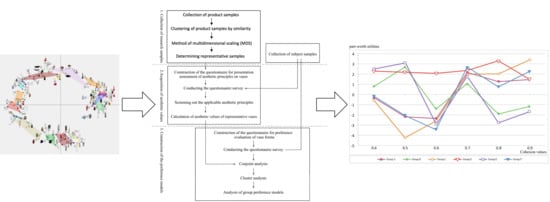Application of Aesthetic Principles to the Study of Consumer Preference Models for Vase Forms
Abstract
1. Introduction
2. Theoretical Background
- The evaluation model of aesthetic measure for analyzing the vase forms.
- Conjoint analysis for analyzing the relationship between the form constructions and consumer preferences.
- Cluster analysis for classifying subjects with different aesthetic tastes into different groups.
2.1. Aesthetic Measure
2.1.1. Symmetry
2.1.2. Minimalism
2.1.3. Cohesion
2.2. Conjoint Analysis
- Understand the relative importance of each attribute level during consumers’ decision-making process.
- Find products’ best attribute combination for a group or an individual.
- Market segmentation can be conducted based on the difference of attribute levels that are emphasized.
- Discover the attribute combinations of products which do not exist on the market but are preferred by consumers.
- Under the assumption that other conditions remain unchanged, the market share of products which are composed of different attribute levels can be estimated based on the judgment of consumer preferences.
2.3. Cluster Analysis
3. Design Execution and Result
3.1. Stage 1-Collection of Research Samples
- The product functions have already been well-developed. In addition, the functions will not differ much when the samples are different.
- For consumers to make a real decision of buying that product, they choose and buy it based on their form preference.
3.2. Stage 2-Acquisition of Aesthetic Values
3.3. Stage 3-Construction of the Preference Models
4. Discussion
4.1. Group A
4.2. Group B
4.3. Group C
4.4. Group D
4.5. Group E
4.6. Group F
5. Conclusions
Funding
Acknowledgments
Conflicts of Interest
References
- Maslow, A.H. Toward a Psychology of Being; Van Nostrand Reinhold: New York, NY, USA, 1968. [Google Scholar]
- Huang, T.S. The form element system design for portable multimedia digital products. J. Des. 2007, 12, 59–77. [Google Scholar]
- Demirbilek, O.; Sener, B. Product design, semantics and emotional response. Ergonomics 2003, 46, 1346–1360. [Google Scholar] [CrossRef] [PubMed]
- Lo, C.H.; Hsiao, S.W. Construction of product aesthetic measures’ evaluation models by aesthetic principles of equilibrium. In Proceedings of the 2013 Chinese Institute of Design Symposium (B-03); Chinese Institute of Design: Kaohsiung, Taiwan, 2013. [Google Scholar]
- Nathan, C. The roles that artefacts play: Technical, social and aesthetic functions. Des. Stud. 2010, 31, 311–344. [Google Scholar]
- Oscar, P.; Jan, S.; Dirk, S. Should new products look similar or different? The influence of the market environment on strategic product styling. Des. Stud. 2008, 29, 30–48. [Google Scholar]
- Tseng, M.M.; Jiao, R.J.; Wang, C. Design for mass personalization. CIRP Ann. Manuf. Technol. 2010, 59, 175–178. [Google Scholar] [CrossRef]
- Best, R.J. Market-Based Management: Strategies for Growing Customer Value and Profitability, 5th ed.; Prentice Hall: Upper Saddle River, NJ, USA, 2009. [Google Scholar]
- Chiu, S.J. Cross-Culture Consumers’ Kansei Research-A Case Study of Mobile Phone; Cheng Kung University: Tainan, Taiwan, 2007. [Google Scholar]
- Hung, W.K.; Chan, L.L. How to Measure Product’s Contradictory Semantics. J. Des. 2010, 15, 41–58. [Google Scholar]
- Lian, Z.W. A Research on Reasoning Model for Identifying the Consumer’s Preference to the Form; Cheng Kung University: Tainan, Taiwan, 2003. [Google Scholar]
- Hsiao, S.W.; Lo, C.H. Effects of product-shape design on customer repurchase intention. Actual Probl. Econ. 2013, 142, 487–497. [Google Scholar]
- Lo, C.H.; Ko, Y.C. An Evaluation Model for Product Aesthetic Measures Constructed by Aesthetic Principles of Balance. In Proceedings of the 2014 International Conference of Organizational Innovation (2014 ICOI), De La Salle University, Manila, Philippine, 12–14 August 2014. [Google Scholar]
- Lo, C.H.; Hsiao, S.W. An Evaluation Model for Product Aesthetic Measures Constructed by Aesthetics Principles of Symmetry. J. Art Des. 2014, 4, 23–41. [Google Scholar]
- Valencia-Romero, A.; Lugo, J.E. Part-Worth Utilities of Gestalt Principles for Product Esthetics: A Case Study of a Bottle Silhouette. ASME J. Mech. Des. 2016, 138, 081102. [Google Scholar] [CrossRef]
- Valencia-Romero, A.; Lugo, J.E. Quantification of Symmetry, Parallelism, and Continuity as Continuous Design Variables for Three-Dimensional Product Representations. In Proceedings of the ASME International Design Engineering Technical Conferences and Computers and Information in Engineering Conference, Volume 7: 28th International Conference on Design Theory and Methodology, Charlotte, NC, USA, 21–24 August 2016; p. V007T06A044. [Google Scholar] [CrossRef]
- Tovares, N.; Boatwright, P.; Cagan, J. Experiential conjoint analysis: An experience-based method for eliciting, capturing, and modeling consumer preference. ASME J. Mech. Des. 2014, 136, 101404. [Google Scholar] [CrossRef]
- Backhaus, K.; Jasper, J.; Westhoff, K.; Gausemeier, J.; Grafe, M.; Stcklein, J. Virtual reality based conjoint analysis for early customer integration in industrial product development. Procedia CIRP 2014, 25, 61–68. [Google Scholar] [CrossRef]
- Orsborn, S.; Cagan, J.; Boatwright, P. Quantifying aesthetic form preference in a utility function. ASME J. Mech. Des. 2009, 131, 061001. [Google Scholar] [CrossRef]
- Chen, W.; Hoyle, C.; Wassenaar, H.J. Decision-Based Design: Integrating Consumer Preferences into Engineering Design; Springer: London, UK, 2013; pp. 1–357. [Google Scholar]
- Kelly, J.C.; Maheut, P.; Petiot, J.-F.; Papalambros, P.Y. Incorporating user shape preference in engineering design optimisation. J. Eng. Des. 2011, 22, 627–650. [Google Scholar] [CrossRef]
- Lugo, J.E.; Batill, S.M.; Carlson, L. Modeling Product Form Preference Using Gestalt Principles, Semantic Space, and Kansei. In Proceedings of the ASME International Design Engineering Technical Conferences and Computers and Information in Engineering Conference, Volume 7: 9th International Conference on Design Education; 24th International Conference on Design Theory and Methodology, Chicago, IL, USA, 12–15 August 2012; pp. 529–539. [Google Scholar] [CrossRef]
- Lugo, J.E.; Schmiedeler, J.P.; Batill, S.M.; Carlson, L. Relationship between product aesthetic subject preference and quantified Gestalt principles in automobile wheel rims. ASME J. Mech. Des. 2016, 138, 051101. [Google Scholar] [CrossRef]
- Lo, C.-H.; Ko, Y.-C.; Hsiao, S.-W. A study that applies aesthetic theory and genetic algorithms to product form optimization. Adv. Eng. Inform. 2015, 29, 662–679. [Google Scholar] [CrossRef]
- Chou, W.C.; Zhang, Q.F. Conjoint Analysis in the Use of the Product Design; Hwa Tai Publisher: Taipei, Taiwan, 2000. [Google Scholar]
- Sanagi, T. Conjoint Analysis by SPSS; Ting Mao Publisher: Taipei, Taiwan, 1989. [Google Scholar]
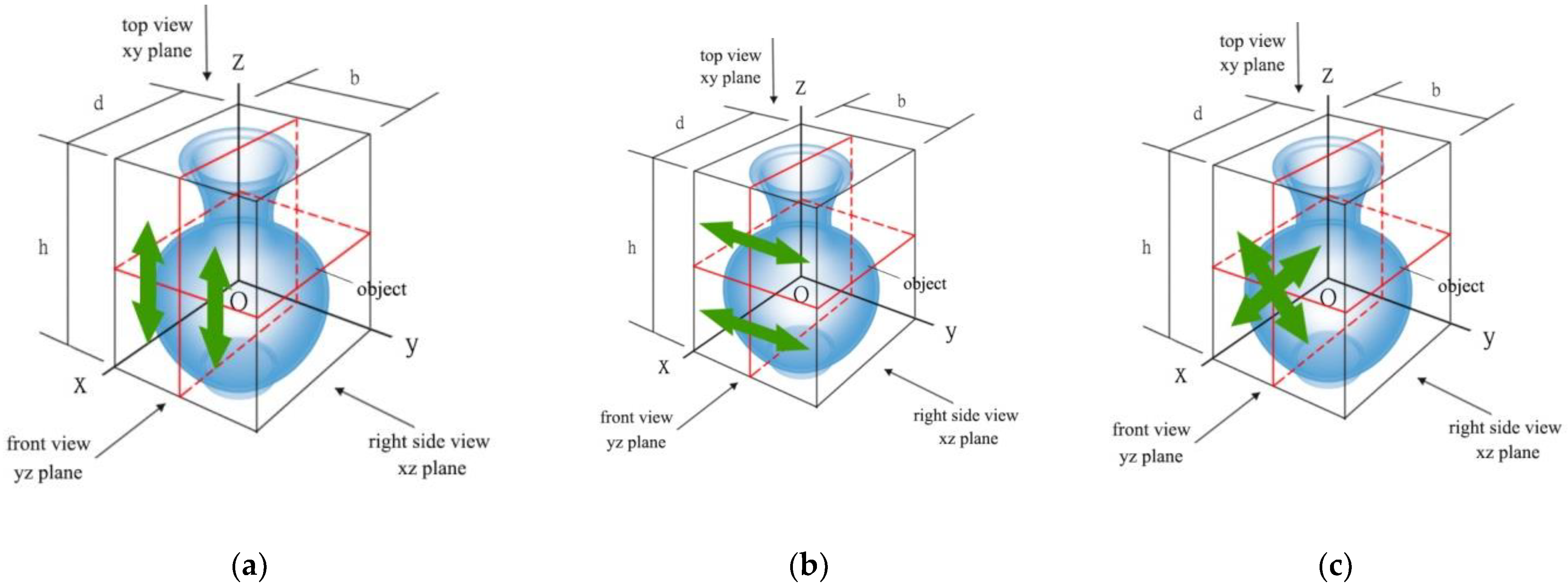




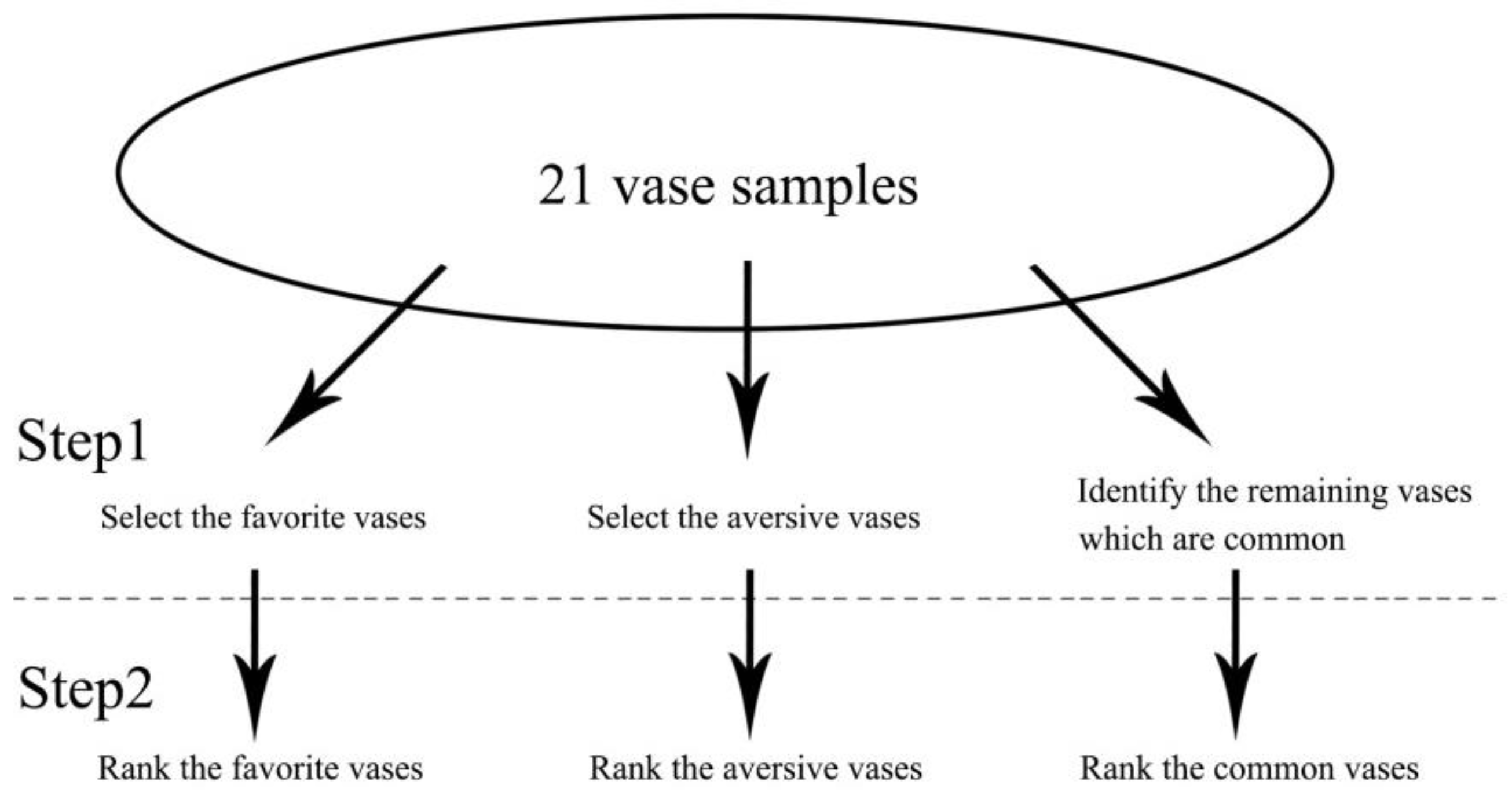

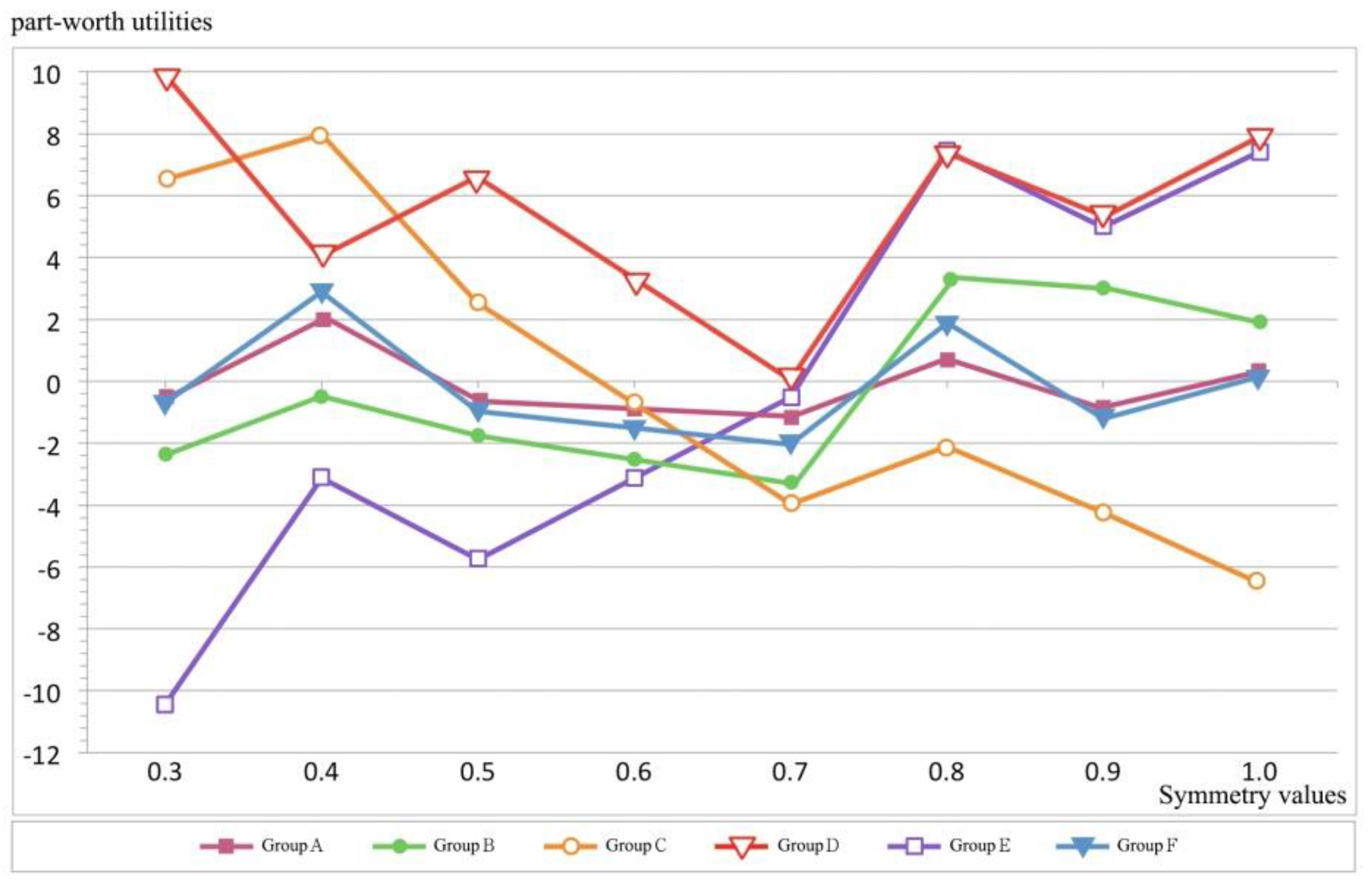

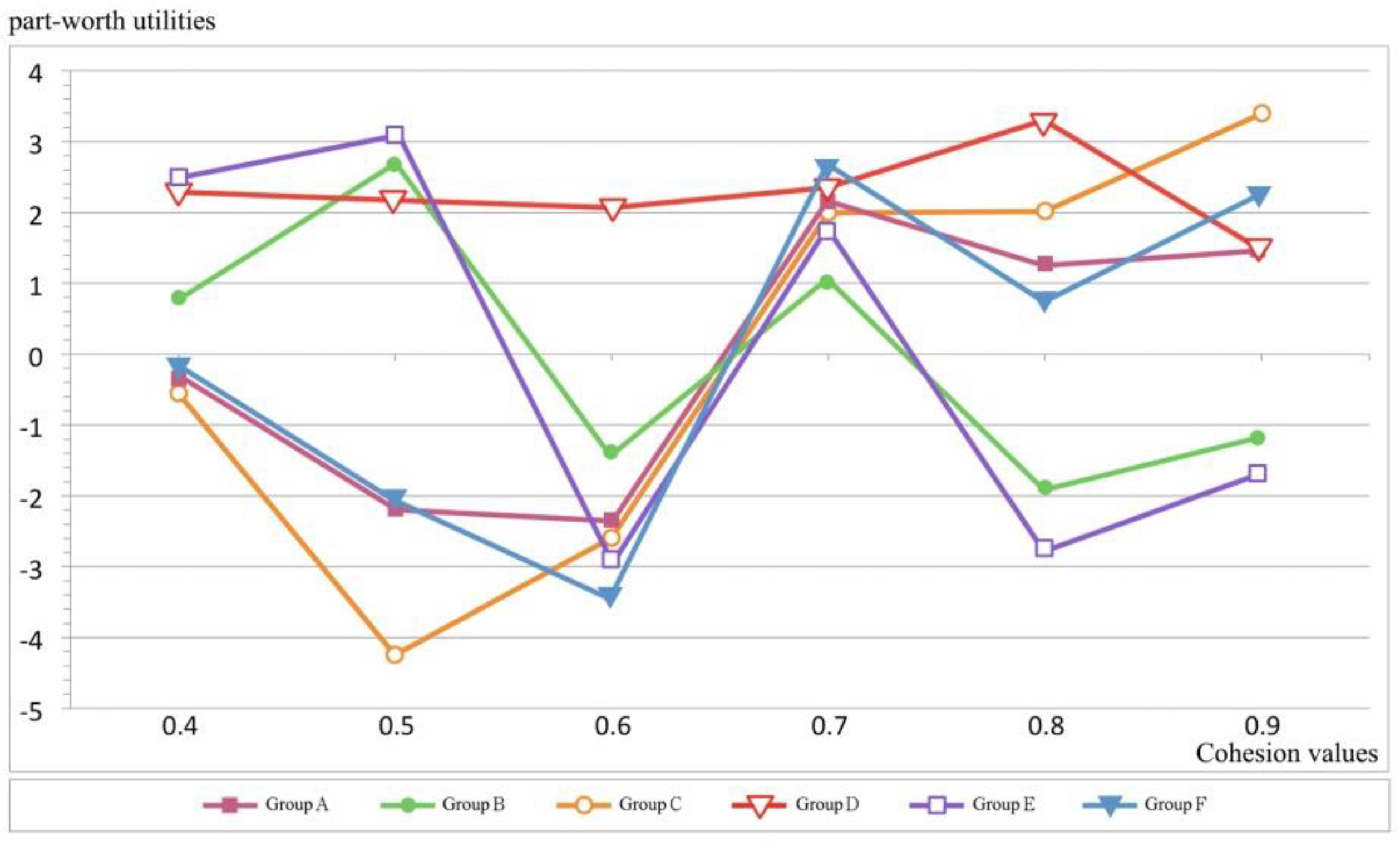
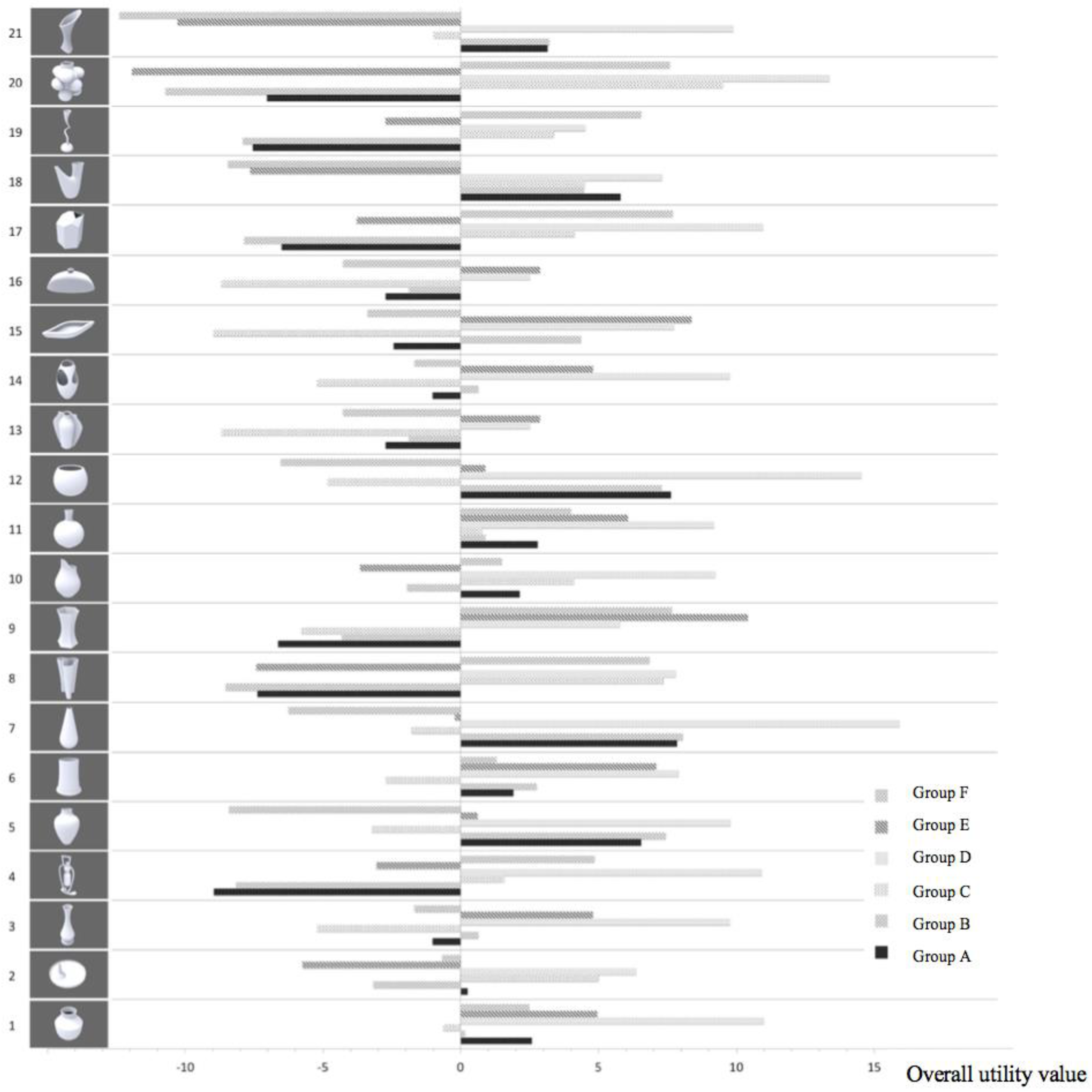
| Gender Breakdown | Design Background | Non-Design Background | Total |
|---|---|---|---|
| Male | 25 | 26 | 51 |
| Female | 29 | 27 | 56 |
| Total | 54 | 53 | 107 |
| Vase Number | Vase Form | Symmetry | Minimalism | Cohesion |
|---|---|---|---|---|
| 1 |  | 0.8 | 0.3 | 0.8 |
| 2 |  | 0.4 | 0.3 | 0.6 |
| 3 |  | 0.8 | 0.3 | 0.6 |
| 4 |  | 0.5 | 0.1 | 0.4 |
| 5 |  | 0.9 | 0.5 | 0.8 |
| 6 |  | 0.9 | 0.3 | 0.7 |
| 7 |  | 0.8 | 1.0 | 0.8 |
| 8 |  | 0.3 | 0.2 | 0.6 |
| 9 |  | 1.0 | 0.2 | 0.6 |
| 10 |  | 0.5 | 0.3 | 0.7 |
| 11 |  | 0.8 | 0.3 | 0.9 |
| 12 |  | 1.0 | 1.0 | 0.9 |
| 13 |  | 0.7 | 0.3 | 0.5 |
| 14 |  | 0.8 | 0.3 | 0.6 |
| 15 |  | 0.9 | 0.3 | 0.5 |
| 16 |  | 0.7 | 0.3 | 0.5 |
| 17 |  | 0.5 | 0.1 | 0.7 |
| 18 |  | 0.4 | 0.5 | 0.6 |
| 19 |  | 0.5 | 0.2 | 0.6 |
| 20 |  | 0.3 | 0.1 | 0.9 |
| 21 |  | 0.5 | 0.5 | 0.6 |
| Aesthetic group | Symmetry 0.3 | Symmetry 0.4 | Symmetry 0.5 | Symmetry 0.6 | Symmetry 0.7 | Symmetry 0.8 | Symmetry 0.9 | Symmetry 1.0 | Minimalism 0.1 | Minimalism 0.2 | Minimalism 0.3 | Minimalism 0.4 | Minimalism 0.5 | Minimalism 1.0 | Cohesion 0.4 | Cohesion 0.5 | Cohesion 0.6 | Cohesion 0.7 | Cohesion 0.8 | Cohesion 0.9 |
|---|---|---|---|---|---|---|---|---|---|---|---|---|---|---|---|---|---|---|---|---|
| A | −0.45 | 2.02 | −0.62 | −0.875 | −1.13 | 0.73 | −0.84 | 0.30 | −8.04 | −4.57 | 0.60 | 3.37 | 6.14 | 5.87 | −0.31 | −2.20 | −2.36 | 2.16 | 1.25 | 1.46 |
| B | −2.41 | −0.52 | −1.78 | −2.555 | −3.33 | 3.30 | 2.93 | 1.81 | −7.14 | −4.71 | −1.23 | 2.59 | 6.41 | 6.66 | 0.76 | 2.67 | −1.42 | 1.06 | −1.90 | −1.17 |
| C | 6.53 | 8.03 | 2.55 | −0.735 | −4.02 | −2.18 | −4.29 | −6.61 | −0.41 | 3.42 | −0.44 | −0.695 | −0.95 | −1.62 | −0.56 | −4.25 | −2.59 | 2.00 | 2.012 | 3.39 |
| D | 9.87 | 4.01 | 6.59 | 3.315 | 0.04 | 7.41 | 5.26 | 7.84 | 2.03 | −4.12 | 0.30 | 0.77 | 1.24 | 5.22 | 2.30 | 2.18 | 2.06 | 2.35 | 3.29 | 1.48 |
| E | −10.44 | −3.12 | −5.75 | −3.13 | −0.51 | 7.43 | 4.99 | 7.41 | 0.18 | 5.95 | 0.31 | −0.64 | −1.59 | −4.85 | 2.51 | 3.07 | −2.94 | 1.79 | −2.79 | −1.67 |
| F | −0.69 | 2.93 | −1 | −1.54 | −2.08 | 1.92 | −1.20 | 0.12 | 6.03 | 10.99 | −0.16 | −4.055 | −7.95 | −8.90 | −0.17 | −2.03 | −3.44 | 2.66 | 0.73 | 2.25 |
© 2018 by the author. Licensee MDPI, Basel, Switzerland. This article is an open access article distributed under the terms and conditions of the Creative Commons Attribution (CC BY) license (http://creativecommons.org/licenses/by/4.0/).
Share and Cite
Lo, C.-H. Application of Aesthetic Principles to the Study of Consumer Preference Models for Vase Forms. Appl. Sci. 2018, 8, 1199. https://doi.org/10.3390/app8071199
Lo C-H. Application of Aesthetic Principles to the Study of Consumer Preference Models for Vase Forms. Applied Sciences. 2018; 8(7):1199. https://doi.org/10.3390/app8071199
Chicago/Turabian StyleLo, Chi-Hung. 2018. "Application of Aesthetic Principles to the Study of Consumer Preference Models for Vase Forms" Applied Sciences 8, no. 7: 1199. https://doi.org/10.3390/app8071199
APA StyleLo, C.-H. (2018). Application of Aesthetic Principles to the Study of Consumer Preference Models for Vase Forms. Applied Sciences, 8(7), 1199. https://doi.org/10.3390/app8071199




